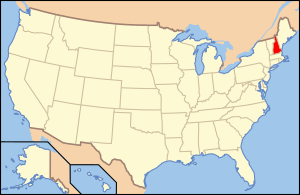Paleontology in New Hampshire facts for kids

Paleontology in New Hampshire is all about studying fossils found in the state of New Hampshire. Finding fossils here is quite rare. This is because most of New Hampshire's rocks are metamorphic. This means they have been changed a lot by heat and pressure.
New Hampshire's long and complex geologic past makes it hard to figure out the exact age of its rocks and any fossils inside them. For example, rocks from the Devonian period are very changed. But rocks from the Mississippian period are much younger, so they haven't been changed as much. Even with these challenges, some amazing fossils have been found!
Millions of years ago, during the early Paleozoic Era, a warm, shallow sea covered New Hampshire. This sea was home to many creatures. These included brachiopods (shellfish), bryozoans (tiny colonial animals), corals, crinoids (sea lilies), and trilobites (ancient sea bugs).
Later, during the Devonian period, the land began to rise. This caused erosion to wash away sediments instead of depositing them. This means there's a big gap in New Hampshire's rock record from that time. Erosion kept happening through the Mesozoic and early Cenozoic eras. Because of this, there are very few rocks from these times, and almost no fossils.
Much more recently, during the Ice Age, huge glaciers covered New Hampshire. The animals and plants living here then were similar to those found in the Canadian Arctic today.
Contents
New Hampshire's Ancient Past
New Hampshire doesn't have a fossil record from before or during the early Paleozoic Era. This is because all the rocks from that time are either igneous (formed from cooled lava) or heavily metamorphosed. However, we can guess what New Hampshire was like by looking at nearby states. It was likely covered by a warm, shallow sea.
Life in the Silurian Sea
During the Silurian period, New Hampshire was home to creatures like brachiopods, bryozoans, corals, crinoids, and trilobites. Their remains were found in a rock layer called the Fitch Formation. One important spot is about 1.7 miles northwest of Littleton.
Other places in the Fitch Formation also have fossils:
- About 2.3 miles west of Littleton, along the Ammonoosuc River, you can find parts of crinoid stems.
- One mile northeast of Lisbon is another place with crinoid stems.
- Two miles northeast of Lisbon, crinoid stems and chain corals are found in marble on the Ammonoosuc River's east bank.
- Another spot for crinoid stems is one mile west of Franconia.
Devonian Period and Mountain Building
During the Devonian period, geological uplift caused mountains to form. New Hampshire was still home to creatures like branchiopods, crinoids, and gastropods (snails).
You can find Devonian fossils at these locations:
- Tip Top Farm, about 3.5 miles west of Littleton.
- Mormon Hill, about 6 miles southwest of Littleton.
- Two miles west of Whitefield, on the northeast side of Dalton Mountain.
The land kept rising through the Carboniferous and Permian periods. As it rose, sediments were washed away instead of building up. This means New Hampshire has no rock record, and thus no fossils, from these times.
Mesozoic Era and the Ice Age
Erosion continued into the Mesozoic Era (the age of dinosaurs). So, New Hampshire has almost no rocks from this entire time. The few rocks that exist were formed from volcanic activity. No dinosaur fossils have ever been found in New Hampshire. In fact, no other fossils are known from this time either.
Erosion continued into the Cenozoic Era. There are no rocks from the Tertiary period in New Hampshire. However, during the more recent Quaternary period, large glaciers covered most of the state. The plants growing here then were like those in modern arctic Canada. We know this from fossil plants and pollen found in sediments left behind when the glaciers melted.
During warmer times between glacial periods, huge animals roamed the area. These included woolly mammoths and mastodons.
Discoveries and Research History
Scientists have been interested in New Hampshire's fossils for a long time.
Early Fossil Reports
In 1873, a scientist named C. H. Hitchcock first wrote about the Silurian brachiopods, bryozoans, corals, crinoids, and trilobites found near Littleton. Later, between 1912 and 1913, F. H. Lahee reported on New Hampshire's Devonian branchiopods, crinoids, and gastropods.
Unique Finds
In 1958, geologists made a "unique" fossil discovery in western New Hampshire. They found a rock layer full of brachiopod shells. Even though the rocks had been changed by metamorphism, the shells were still mostly recognizable! The shells were often separated, probably because of ancient ocean currents. These fossils were found in a rock unit called the Clough Formation, which is made of crystalline calcite with other minerals. It likely dates back to the Early Silurian period.
More recently, in 2013, mastodon fossils were found off the Isles of Shoals. In 2014, a mammoth tooth was also discovered.
Fossils on Display
A skull cast of a mosasaur called Tylosaurus is on display. You can see it in James Hall at the University of New Hampshire in Durham.
Notable Paleontologists
James Hall, a famous paleontologist, passed away in Bethlehem on August 7, 1898.
Natural History Museums
If you want to see more about natural history, check out these museums in New Hampshire:
- The Little Nature Museum at Gould Hill Orchards, Hopkinton
- Squam Lakes Natural Science Center, Holderness
- Woodman Institute, Dover

